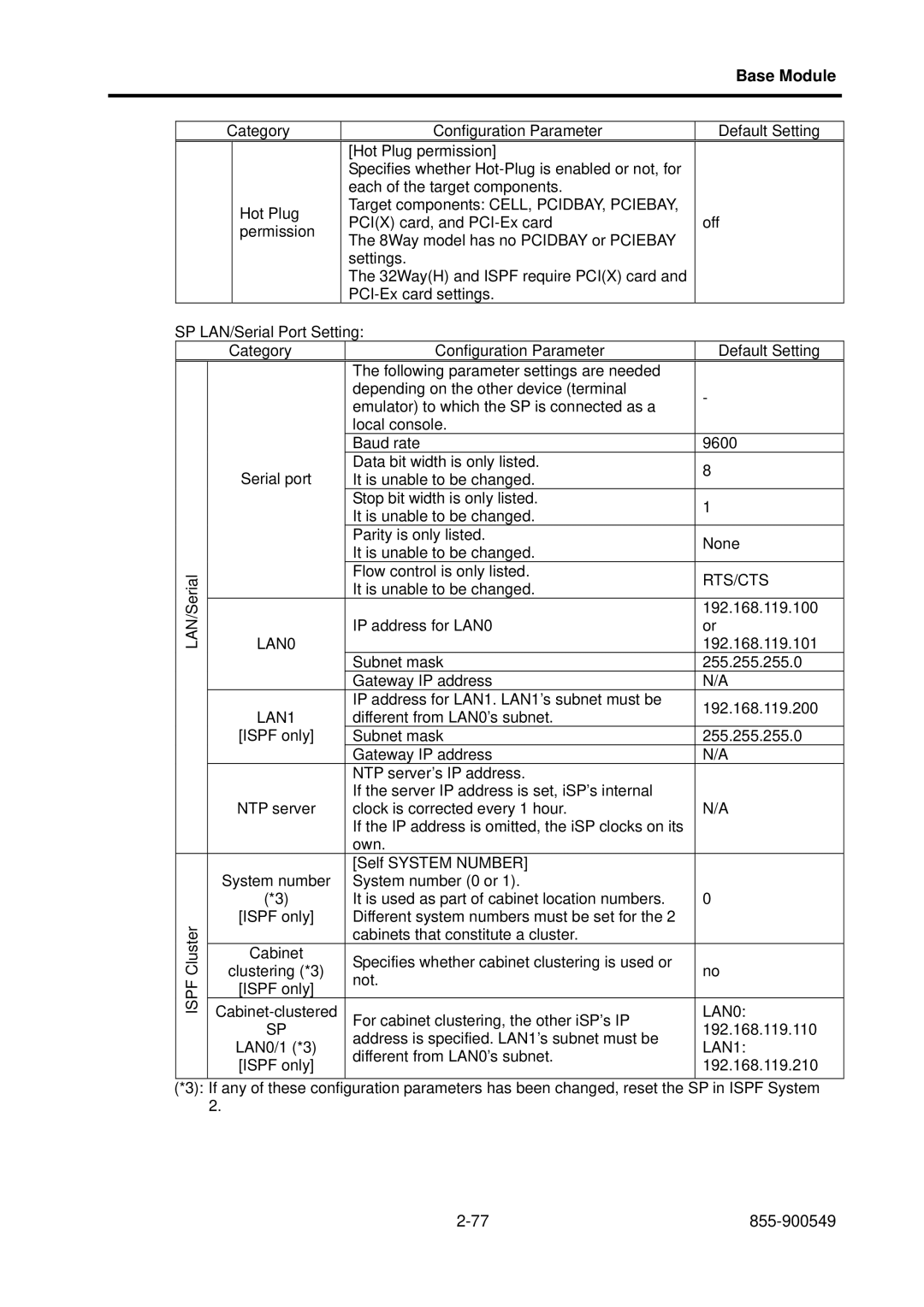|
|
|
|
|
| Base Module |
|
|
|
|
|
|
|
|
|
|
|
|
|
|
|
| Category |
| Configuration Parameter | Default Setting | |
|
|
|
|
| [Hot Plug permission] |
|
|
|
|
|
| Specifies whether |
|
|
|
|
|
| each of the target components. |
|
|
|
| Hot Plug |
| Target components: CELL, PCIDBAY, PCIEBAY, | off |
|
|
|
| PCI(X) card, and | ||
|
|
| permission |
| ||
|
|
|
| The 8Way model has no PCIDBAY or PCIEBAY |
| |
|
|
|
|
|
| |
|
|
|
|
| settings. |
|
|
|
|
|
| The 32Way(H) and ISPF require PCI(X) card and |
|
|
|
|
|
|
| |
SP LAN/Serial Port Setting: |
| |||||
|
| Category |
| Configuration Parameter | Default Setting | |
|
|
|
|
| The following parameter settings are needed |
|
|
|
|
|
| depending on the other device (terminal | - |
|
|
|
|
| emulator) to which the SP is connected as a | |
|
|
|
|
|
| |
|
|
|
|
| local console. |
|
|
|
|
|
| Baud rate | 9600 |
|
|
| Serial port |
| Data bit width is only listed. | 8 |
|
|
|
| It is unable to be changed. | ||
|
|
|
|
| ||
|
|
|
|
| Stop bit width is only listed. | 1 |
|
|
|
|
| It is unable to be changed. | |
|
|
|
|
|
| |
|
|
|
|
| Parity is only listed. | None |
|
|
|
|
| It is unable to be changed. | |
|
|
|
|
|
| |
| LAN/Serial |
|
|
| Flow control is only listed. | RTS/CTS |
|
| LAN0 |
| It is unable to be changed. | ||
|
|
| 192.168.119.101 | |||
|
|
|
|
|
| |
|
|
|
|
|
| 192.168.119.100 |
|
|
|
|
| IP address for LAN0 | or |
|
|
|
|
|
|
|
|
|
|
|
| Subnet mask | 255.255.255.0 |
|
|
|
|
| Gateway IP address | N/A |
|
|
|
|
| IP address for LAN1. LAN1’s subnet must be | 192.168.119.200 |
|
|
| LAN1 |
| different from LAN0’s subnet. | |
|
|
|
|
| ||
|
|
| [ISPF only] |
| Subnet mask | 255.255.255.0 |
|
|
|
|
| Gateway IP address | N/A |
|
|
|
|
| NTP server’s IP address. |
|
|
|
|
|
| If the server IP address is set, iSP’s internal |
|
|
|
| NTP server |
| clock is corrected every 1 hour. | N/A |
|
|
|
|
| If the IP address is omitted, the iSP clocks on its |
|
|
|
|
|
| own. |
|
|
|
|
|
| [Self SYSTEM NUMBER] |
|
|
| System number |
| System number (0 or 1). | 0 | |
|
| (*3) |
| It is used as part of cabinet location numbers. | ||
| Cluster |
| [ISPF only] |
| Different system numbers must be set for the 2 |
|
|
|
|
| cabinets that constitute a cluster. |
| |
|
| Cabinet |
| Specifies whether cabinet clustering is used or | no | |
|
|
|
| |||
|
| clustering (*3) |
| |||
| ISPF |
| not. | |||
|
| [ISPF only] |
|
| ||
|
|
|
|
| ||
|
|
|
|
|
| |
|
|
| For cabinet clustering, the other iSP’s IP | LAN0: | ||
|
|
| SP |
| address is specified. LAN1’s subnet must be | 192.168.119.110 |
|
|
| LAN0/1 (*3) |
| LAN1: | |
|
|
|
| different from LAN0’s subnet. | ||
|
|
| [ISPF only] |
| 192.168.119.210 | |
|
|
|
|
| ||
|
|
|
|
|
|
|
(*3): If any of these configuration parameters has been changed, reset the SP in ISPF System 2.
